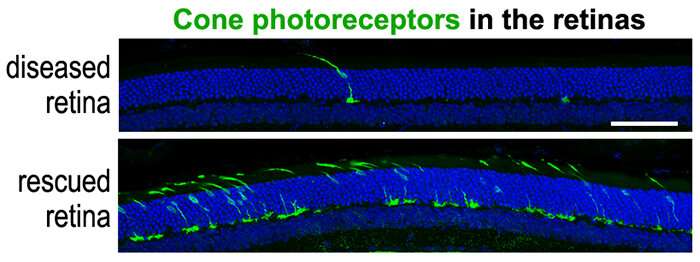
A team of LSU Health New Orleans researchers reports for the first time that deleting one of the inhibitors of the RPE65 gene in a mouse model that carries a human disease mutation prevents degeneration of cone photoreceptors that are used for daytime high-resolution color vision. Their findings are published in PNAS.
More than 100 DNA variants in the RPE65 gene are reported as pathogenic mutations causing retinal degenerative diseases. They include a group of inherited childhood blinding diseases called Leber congenital amaurosis (LCA). While a new gene therapy may improve vision for some with RPE65 gene mutations, there is currently no effective therapy that arrests progressive retinal degeneration in LCA.
Previously, the researchers identified three inhibitors of RPE65. The one involved in the current study is called fatty acid transport protein 4 (FATP4). They found that the survival of cone photoreceptors is increased nearly 10-fold in the mouse model of LCA lacking FATP4 in the retina. They also discovered that partial reduction of FATP4 in the retina can improve the survival and visual function of cone photoreceptors. These findings establish FATP4 as a promising therapeutic target to preserve daytime color vision in patients.
“The role of FATP4 in disease progression of retinal dystrophies associated with RPE65 mutations was completely unknown,” notes Nicolas Bazan, MD, Ph.D., Boyd Professor, Ernest and Yvette C. Villere Endowed Chair for Retinal Degenerative Diseases and Director of the Neuroscience Center of Excellence at LSU Health New Orleans School of Medicine. “This study is the first to uncover that FATP4 plays a pivotal role in photoreceptor survival and function in retinal dystrophies.”
According to the National Institutes of Health, Leber congenital amaurosis primarily affects the retina, the specialized tissue at the back of the eye that detects light and color. Beginning in infancy, people with LCA typically have severe visual impairment. The National Library of Medicine says Leber congenital amaurosis occurs in 2 to 3 per 100,000 newborns. It is one of the most common causes of blindness in children.
Source: Read Full Article





